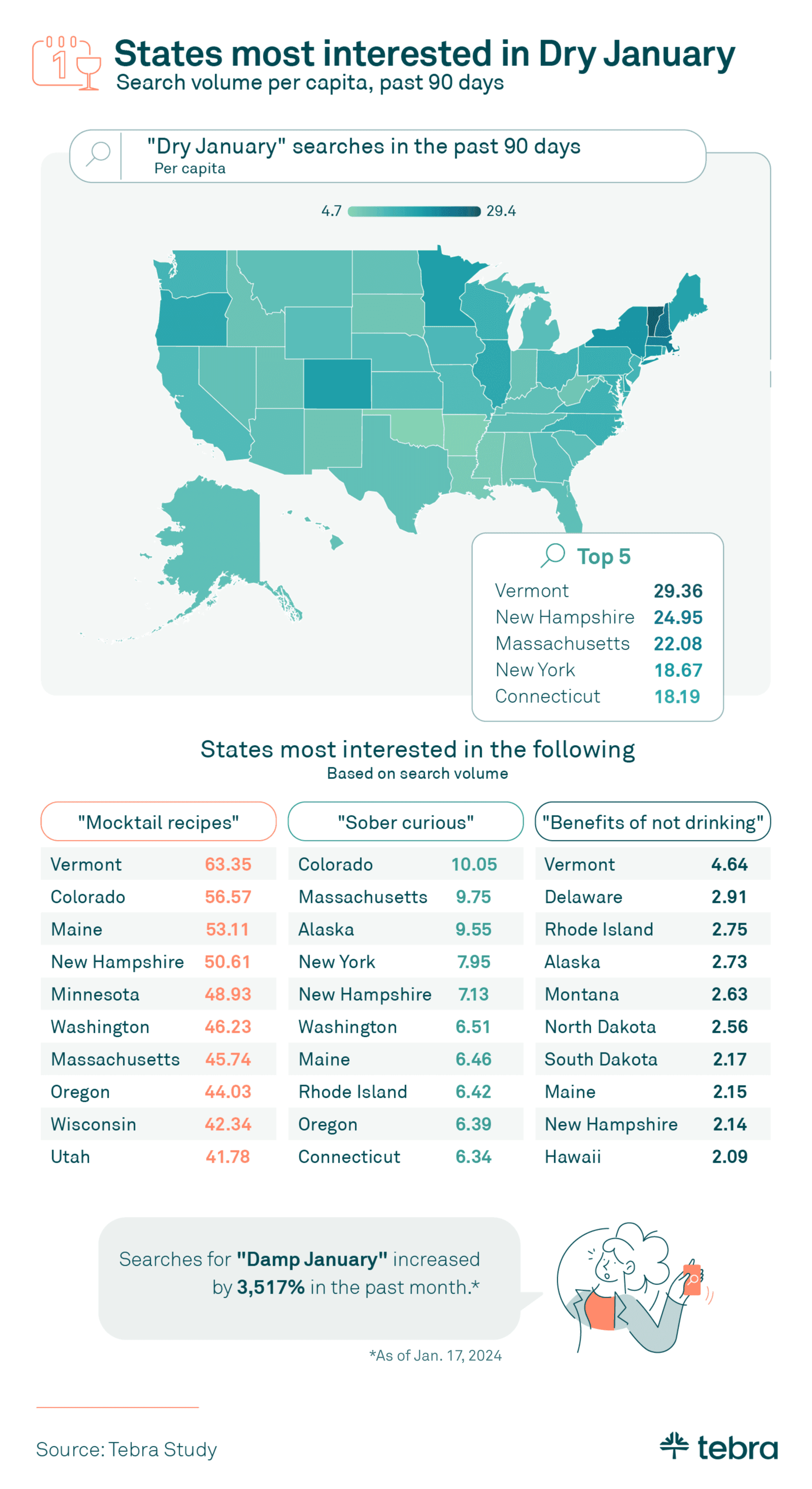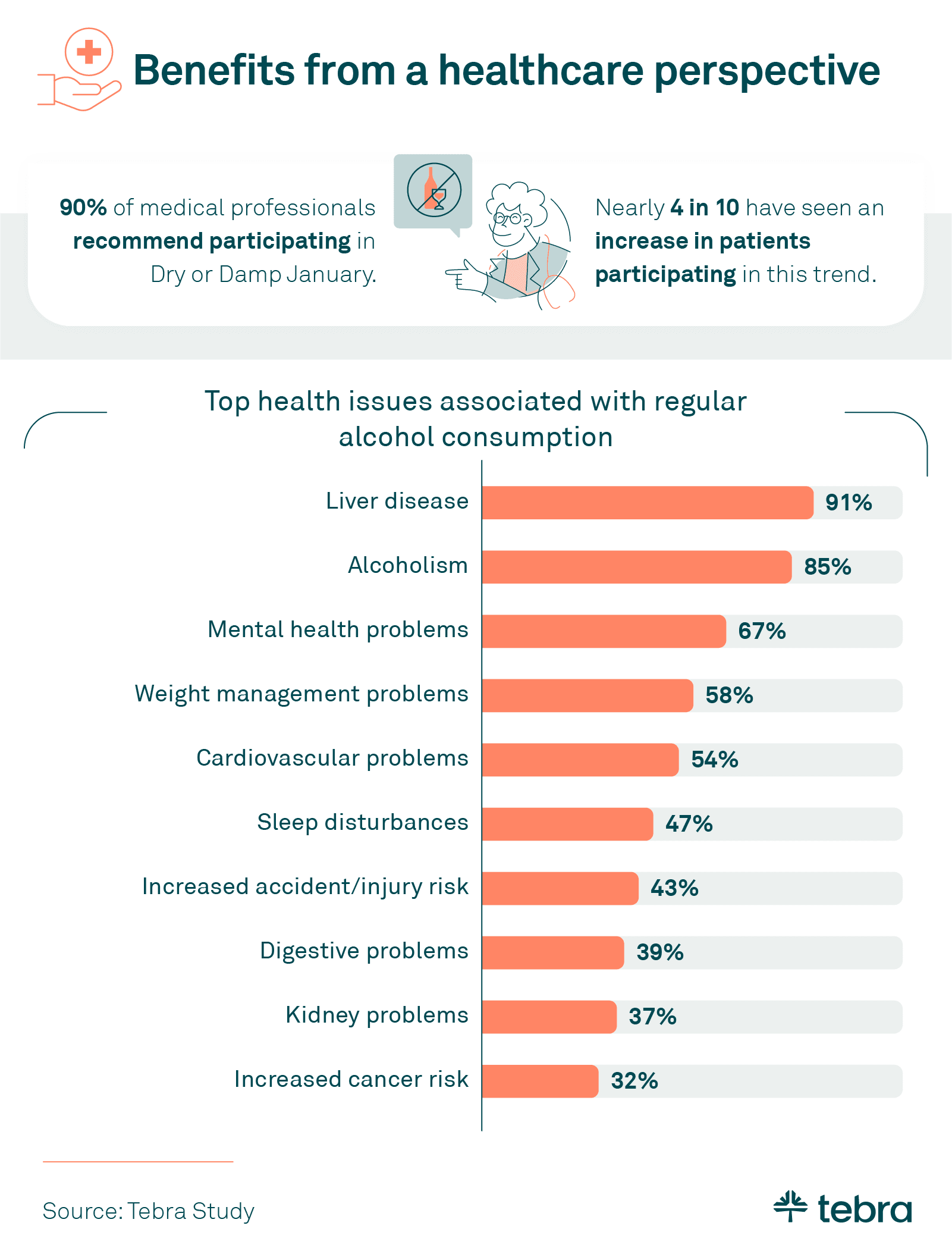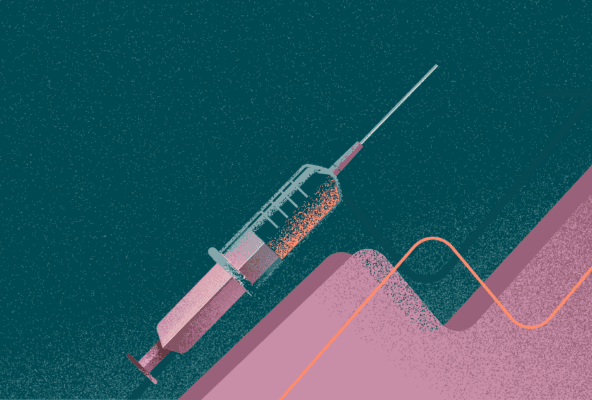Tebra researched the trends of removing alcohol from the daily lives of sober-curious Americans. Learn about the benefits of cutting back on drinking across the U.S. and the impact to patients and their providers, based on our findings and data.
The Dry January trend has gained significant momentum in recent years. After a season of indulgence, many people stop or cut back on drinking during the month following their celebrations. To shed light on these increasingly popular trends, we looked at regional search volume and surveyed health professionals to weigh in.
Key takeaways
- Vermont is the state most interested in “Dry January” based on search volume, with 29 searches per capita in the past 3 months. Vermont residents are also searching the most for “mocktail recipes” (63 searches per capita).
- Oklahoma is least interested in “Dry January,” with less than 5 searches per capita.
- 9 in 10 healthcare professionals recommend participating in Dry January or Damp January.
- Medical professionals say the top short-term benefits they see in patients who reduce their alcohol consumption are enhanced mental clarity and focus (69%) and improved sleep quality (65%).
Sober-curious states 2023 -2024
Below, we explore the states most (and least) interested in alcohol consumption reduction by diving into search volume trends from the past 3 months.
U.S. States most interested in Dry January

Alcohol consumption and reduction by states takeaways
Vermont was the state most interested in “Dry January,” with 29 searches per capita in the past 3 months. Vermont residents were also searching the most for “mocktail recipes” (63 searches per capita). Mocktails are popular alcohol-free alternatives for anyone looking to reduce or eliminate alcohol intake. Overall, searches for “Damp January” have increased by 3,517% in the last month. However, some states seemed less interested in others.
States searching for “Dry January” the least (searches per capita)
- Oklahoma (4.7)
- Arkansas (5.5)
- Mississippi (6.5)
- Louisiana (6.6)
Meanwhile, some major cities showed a particular interest in cutting back on drinking compared to others.
Cities searching for “Dry January” the most (searches per capita)
- Atlanta, GA (77.5)
- Minneapolis, MN (71.8)
- Washington, D.C. (50.7)
- Boston, MA (50.3)
- Denver, CO (44.3)
- Seattle, WA (44.2)
- Miami, FL (43.6)
- San Francisco, CA (41.9)
- Tampa, FL (40.7)
- Portland, OR (38.8)
Health professionals weigh in
We wanted to explore the health benefits of cutting back alcohol consumption from an expert’s view. So, we surveyed healthcare professionals about the benefits and risks that come with drinking and cutting it out.

Although the vast majority of healthcare professionals (90%) recommended participating in Dry January or Damp January, less than 4 in 10 said they’ve seen an increase in these trends in recent years. They also shared the top benefits that they have seen in patients who reduce their alcohol consumption.
Top 10 short-term health benefits of reducing alcohol consumption
- Enhanced mental clarity and focus (69%)
- Improved sleep quality (65%)
- Increased energy (64%)
- Improved hydration and skin health (62%)
- Improved liver function (56%)
- Fewer mood swings and irritability (54%)
- Reduced accidents and injuries (54%)
- Ability to make healthier lifestyle choices (50%)
- Better weight management (44%)
- Healthier blood pressure (32%)
Top 10 long-term health benefits of reducing alcohol consumption
- Reduced risk of liver diseases such as cirrhosis and fatty liver (88%)
- Enhanced mental health, including lower risks of depression and anxiety (67%)
- Lowered risk of hypertension and stroke (64%)
- Reduced risk of developing alcohol dependence or addiction (61%)
- Longer lifespan and improved overall quality of life (56%)
- Improved cardiovascular health (54%)
- Reduced risk of alcohol-induced sleep disorders (51%)
- Weight improvement (51%)
- Better weight management (44%)
- Improved cognitive functions and potentially lower risk of dementia (42%)
Our dry January medical risk takeaways
The short term benefits of weight management and the long term benefits are the same, at 44% . The top short term benefit of limiting alcohol according to the medical professionals polled was enhanced mental clarity and focus. Long term, the medical professionals agreed that the reduced risk of liver diseases was the most important benefit, with hypertension and stroke in third.
With longer lifespan and quality of life at number 5 of long term benefits, it is clear that participating in dry January trends or making a permanent choice to become sober is important to health professionals as a lifestyle change.
Changes to make today
If patients and their doctors are interested in participating in sober-curious trends, here are some ideas to research.
- Mocktails. Creating cocktails with no alcohol is becoming easier as brands are catching on to the health benefits of not drinking. Look for mocktail recipes, and social hashtags for #mocktails.
- Sober curious. Searching discussions about "Sober curious" as well as instagram, tiktok and blogs could help shed light on ways to dive into the lifestyle change steps.
- Damp January. This trend of cutting back on alcohol for 30 days is worth searching, as studies show that cutting back on alcohol to moderate levels (2 drinks or less per day for men, 1 day or less for women as per the National Institute of health) can also have negative effects on long term health. Per the mayo clinic, any amount of drinking increases the risk of breast cancer and colorectal cancer. As consumption goes up, the risk goes up for these cancers. It is a tiny, but real, increased risk.
Methodology
We collected search volume data from 50 states and the top 50 most populous cities to explore interest in reducing alcohol consumption and the interest in the Dry January trend. Search volume data was collected in January 2024 from the past 90 days. We then determined the search volume per capita among states and cities to see which are the most interested in various aspects related to Dry/Damp January. We also surveyed 221 medical professionals on Connect and Prolific to explore the benefits from a medical perspective and gain expert insights on these trends.
About Tebra
In 2021, with a combined mission to unlock better healthcare, Kareo and PatientPop joined forces to form Tebra. Tebra provides digital tools and support to independent practices so they may deliver modern care and operate efficiently. To learn more about how Tebra is committed to improving patients’ and providers’ success and well-being, visit www.tebra.com.
Fair use statement
All readers are welcome to share the findings presented in this article for non-commercial purposes. When sharing, please provide a link back to this Tebra page.






